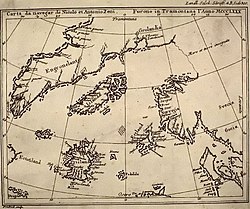Phantom island
A phantom island is an island that was thought to exist at some point in time. Because of this, the island was shown on a map. Later, the islands were removed from maps. Some islands are described and later on change their name, or with the description given it is possible to associate a real island. Other islands sink below sea level because of natural causes such as erosion. Such islands still exist. Two examples are Earnest Legouve Reef and Maria-Theresa Reef in the South Pacific. Because they are far away from ships' routes, their existence can not be proved so far. In the year 1908, Robert Peary claimed to have found a lost continent, called Crocker Land.
People such as João Vaz Corte-Real were rewarded for finding islands that turned out to be phantom islands. In the case given, the phantom island was Bacalao. The island showed up on maps in the early 16th century. Baccalieu Island is probably named after the phantom island.
Some phantom islands were later found. That way Baja California was first thought to be an island. Later, people found it was in fact a peninsula. Thule was discovered in antiquity; in modern times, people who found it may have talked about Norway, the Orkney Islands, Shetland or Scandinavia. Other interpretations include Iceland, Greenland, or the island Saaremaa in the Baltic Sea.
Other phantom islands may exist because of mistakes in navigation, or optical illusions, such as superior mirage. One example of this is New South Greenland, which was observed in the Weddell Sea in 1823, and has not been seen since.
Some phantom islands may have existed, but they have been destroyed, or are no longer above the water line. These include Thompson Island in the South Atlantic, and Bermeja, off the coast of Yucatán.
Phantom Island Media
Fragment of George Powell's 1822 chart of the South Shetland Islands showing the phantom Middle Island (bottom right) in Bransfield Strait, Antarctica
The Zeno map of 1558 showing Frisland – a phantom island in the North Atlantic
The phantom island of Kianida or Cianeis in the Black Sea on a fragment of the 1467 Nicolaus Germanus edition of Ptolemy's Geography



